Exploring Motorized Water Boards: Innovation on Waves
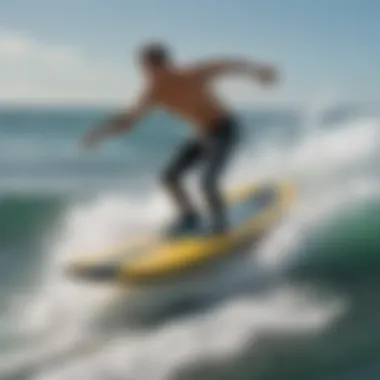
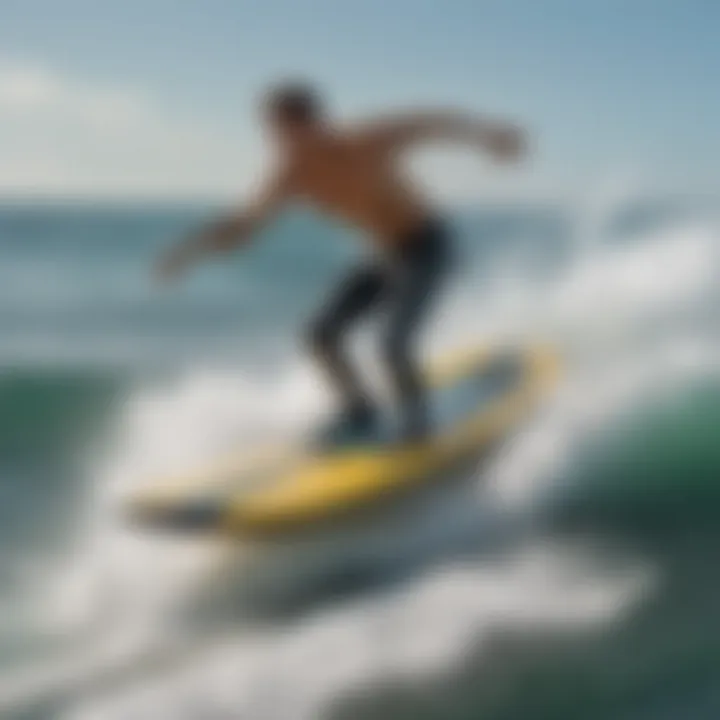
Intro
The world of water sports is ever-evolving, constantly pushing the limits of technology and creativity. As surfers and water enthusiasts look for new ways to ride the waves, a notable innovation has emerged: motorized water boards. These boards blend the adrenaline of surfing with the convenience of modern technology, promising an exhilarating experience on the water.
Imagine gliding across the surface, powered by an electric motor, with the ocean breeze against your face. Unlike traditional surfboards, which rely on wave power, motorized boards offer a unique way to surf, enabling riders to carve through the water with ease, regardless of the wave conditions. This seamless fusion is attracting surfers of all skill levels, from the seasoned pros who seek to push their limits to newcomers eager to make a splash.
In this detailed exploration, we will discuss the technology behind these boards, their impact on surfing culture, and practical considerations for anyone interested in getting on board—both literally and metaphorically. Key themes include comparisons with conventional surfboards, safety measures, the legal landscape surrounding their use, and the environmental footprint of this exciting new sport. We will conclude with maintenance advice and insights from users, painting a holistic picture of motorized water boards and their place in the surfing community.
The waves are calling, and the next chapter in surfing innovation is here. Let’s dive into this venture, exploring all angles to provide a comprehensive view of this modern-day marvel.
Preamble to Motorized Water Boards
The past decade has seen a remarkable leap in water sports technology, and motorized water boards stand at the forefront of this evolution. These innovative boards combine the thrill of surfing with the convenience of powered propulsion, attracting a diverse range of enthusiasts from casual beachgoers to seasoned surfers. By integrating advanced engineering, these boards are not just devices but also gateways to new experiences on the waves.
Motorized water boards signify a shift in how we interact with the ocean. They offer the ability to navigate waters with less effort, allowing users to explore farther and ride for longer periods. This ease of use not only attracts newcomers but also provides seasoned surfers a new avenue for expression and adventure. Whether you’re catching a wave or gliding across calm waters, the unique experience these boards offer changes the landscape of water sports.
Definition and Overview
Motorized water boards can be defined as surfboards equipped with an engine or propulsion system that allows the rider to travel without relying solely on wind or waves. Essentially, they are a fusion of traditional surfing with modern technology. Most designs include a streamlined board, a propulsion mechanism, and usually a control system, allowing the rider to manage speed and direction.
These boards have become increasingly popular not only because of their thrilling ride but also due to their accessibility. Riders can enjoy the water without needing perfect ocean conditions, opening the door for a more inclusive water sports culture. As technology advances, we can expect these boards to become even more versatile and user-friendly.
Historical Context
To truly understand the emergence of motorized water boards, it is essential to look back at the history of water sports. Traditional surfing dates back thousands of years to the Polynesian islands, where native cultures crafted their boards from local materials. Over time, surfing evolved with various styles and methodologies, greatly influenced by advancements in materials and design.
The turning point came around the mid-to-late 20th century when technology began to revolutionize active water sports. The introduction of personal watercraft in the 1960s paved the way for increased speed and accessibility on the water. Fast forward a few decades, and we now see a growing interest in combining these concepts—thus, the motorized water board was born. This creation arose from a desire to enhance the user experience and revolutionize traditional surfing, merging thrill with practicality.
The backdrop of surf culture has also been pivotal. As surfing grew in popularity, so did experiments in board design, leading to innovation that would inevitably lead to the motorized variety. Today, surfers are no longer limited to the waves; they can zip along the coast, gliding effortlessly, while also enjoying all the environmental joys the ocean provides.
"Motorized water boards not only redefine the ride but also redefine our relationship with the waves. They invite exploration beyond conventional surfing.”
As we delve deeper into this article, we will explore the various aspects that make motorized water boards a significant innovation, their underlying technology, and how they continue to shape the future of water sports.
Technology Behind Motorized Water Boards
The technology that propels motorized water boards is nothing short of revolutionary for water sports. This section aims to shed light on key components that contribute to the functionality and performance of these remarkable boards, showing how they stand apart from their traditional counterparts. With an intricate blend of engineering and cutting-edge technology, motorized water boards promise to enhance the overall experience for both enthusiasts and professionals alike.
Engineering and Design
When it comes to motorized water boards, design and engineering play pivotal roles. These boards are not just oversized surfboards; they are precision-crafted tools sculpted to offer both speed and stability on the water. The materials used often include lightweight composites and high-strength plastics, ensuring that the boards can be maneuvered easily without compromising durability.
Think of it this way: a quality board blends form and function seamlessly. The streamlined design reduces drag, allowing riders to cut through waves with minimal resistance. The aesthetics can vary widely, from sleek, futuristic appearances to vibrant, eye-catching patterns that appeal to individual styles. More than just good looks, effective engineering directly impacts the user experience, making the thrill of riding more accessible to a broader audience.
Battery and Propulsion Systems
The heart of any motorized water board lies in its battery and propulsion systems. Most commonly, these boards employ lithium-ion batteries, revered for their long life and lightweight properties. The propulsion system typically consists of a high-efficiency motor that can adjust the thrust depending on the rider's preferences.
This technology ensures that riders can achieve speeds that were once the domain of jet skis, yet with a more streamlined and agile platform. Riders familiar with water sports will appreciate the responsiveness that comes from a well-engineered propulsion system. Optimum thrust translates to control; thus, even beginners find it less daunting to navigate waves.
- Advantages of Modern Propulsion Systems:
- Increased efficiency and lower energy consumption.
- Quieter operation, which is less disruptive to the environment and marine life.
- Adjustable speed settings to suit the user's skill level.
Control Mechanisms
The marvel of motorized water boards is not just in how fast they can go, but also in how easily they can be controlled. Steering and balance mechanisms have evolved tremendously. Many boards now come equipped with remote control systems or intuitive handheld devices, allowing riders to manage speed and direction with the flick of a finger.
Moreover, manufacturers ensure that safety is paramount in their design. Some boards incorporate stability-sensitive technology that assists riders in maintaining balance even in turbulent waters. The ultimate goal is to create an experience that feels natural, allowing riders to focus on the thrill of the ride rather than the mechanics of control.
"The evolution of control technologies in motorized water sports demonstrates an increased commitment to rider safety and enjoyment, making the sport more appealing and inclusive to newcomers."
In summary, the technology behind motorized water boards represents a blend of innovative engineering, efficient energy systems, and user-friendly control mechanisms. As the sector evolves, so too does the potential for growth and accessibility in this exciting form of water sport.
Comparison with Traditional Surfboards
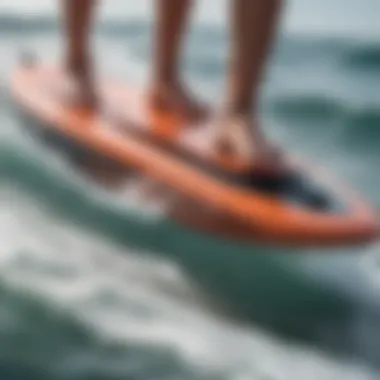
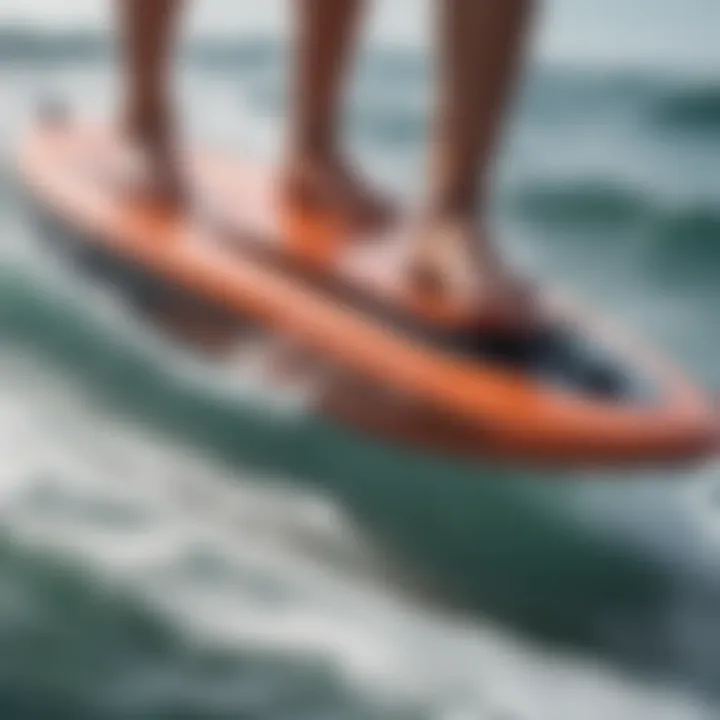
When discussing motorized water boards, a necessary comparison to traditional surfboards emerges. This comparison not only scrutinizes their structural and functional differences but also lays the groundwork for understanding how motorized boards augment or alter the surfing experience. The interplay these boards have with the typical surf culture, as well as their unique characteristics, is crucial in appreciating their place in the evolving realm of water sports.
Performance Metrics
The performance metrics of motorized water boards diverges significantly from traditional models. While both types are designed for gliding across water, the speed, maneuverability, and durability present stark contrasts. Motorized boards can achieve higher speeds due to the integrated propulsion systems, allowing for quick bursts that traditional surfboards simply cannot match. Surfers can hit impressive velocities, getting more thrill with less effort.
In terms of maneuverability, motorized boards offer greater versatility through advanced steering mechanisms and often include settings for beginners to pro-level users. Traditional boards, though providing a more tactile connection to the waves, may not allow for the rapid adjustments possible with motorized variants. Here’s a look at some key performance metrics:
- Speed: Motorized boards can reach speeds upwards of 25 miles an hour, while traditional surfboards generally average around 5 to 15 miles an hour.
- Acceleration: The instant thrust from the motor gives users a faster rate of acceleration compared to paddling on a surfboard.
- Wave Utilization: Traditional boards rely entirely on wave power, while motorized boards can generate their own wave as they ride.
User Experience
When it comes to user experience, the juxtaposition is both broad and subtle. Motorized boards provide an invigorating ride—allowing users to feel the wind and spray at unprecedented speeds—but they can remove some of the skill and physicality associated with surfing. Riders often share an exhilarating experience, zipping across the water, yet some traditional surfers feel that this swift engagement detaches them from the essence of the ocean.
Moreover, the user interface on motorized boards can vary widely from complex controls to simplistic designs. Riders using these boards often report a unique sense of freedom, given that they can explore various marine terrains that would otherwise be unreachable with traditional surfing techniques. Still, it’s notable that many die-hard surfers find deep value in the discipline and artistry of paddling and riding waves traditionally.
Skill Requirements
The skill sets required for operating motorized water boards differ markedly from their traditional counterparts. While traditional surfing necessitates extensive knowledge of wave dynamics and surf etiquette, motorized boards call for a different set of proficiencies related to handling machinery. Riders must still possess a foundational understanding of balance and weight distribution, yet knowing how to control the throttle and navigate effectively becomes crucial.
It can be beneficial to take training lessons when starting with a motorized board. Many users may not be accustomed to adjusting their body weight in response to motor power adjustments, a skill that might require some time to master. Here are several suggested skills:
- Throttle Control: Understand the intricacies of accelerating and decelerating swiftly without losing balance or control.
- Navigation: Familiarity with directional changes and how to turn effectively at speed.
- Safety Protocols: Learn the rules concerning motorized watercraft and surf zones to avoid conflicts with traditional surfers.
In summary, the comparison between motorized water boards and traditional surfboards reveals a fascinating evolution in the surf experience. Each offers unique thrills and challenges, but the choice one makes speaks to their personal preferences for speed, engagement, and skill development.
Safety Considerations
When it comes to motorized water boards, prioritizing safety isn't just smart; it’s essential. These boards can offer thrilling experiences on the water, but with this excitement comes a certain level of risk. Understanding safety considerations associated with motorized water sports can enhance enjoyment while reducing potential accidents.
Personal Protective Equipment
Donning the right gear can often spell the difference between a day of fun and a trip to the emergency room. Personal protective equipment (PPE) is your first line of defense against mishaps. Here’s what one should consider:
- Life Jackets: Always wear a personal flotation device. It’s like an insurance policy; you might not want it, but it can save your life.
- Helmets: Protect your noggin from falls or collisions. Even seasoned riders can take a tumble.
- Wetsuits: These are not just for warmth. They provide some cushioning during inevitable wipeouts and help decrease the risk of hypothermia in colder waters.
- Impact Vests: Consider wearing a vest designed to absorb shock. These can minimize injuries from impacts, whether from hitting the board or rough water.
Ultimately, wearing adequate PPE fosters confidence. When one feels secure in their attire, they can focus more on the act of riding rather than worrying about potential dangers.
Avoiding Hazards
Navigating the waves doesn’t come without its hazards. Being aware of these potential threats is crucial:
- Obstructions: Always scout the area for underwater hazards like rocks or piers. Just one wrong turn can result in injuries.
- Weather Conditions: Keep an eye on the sky; storms can pop up unexpectedly. Rain and high winds can turn relatively calm waters into a treacherous environment.
- Water Traffic: Be aware of other boats and surfers. Respect their space and keep a safe distance, as collisions can be very dangerous.
- Fatigue: Know your limits. The thrill of riding can push you to the max, but exhaustion can impair your judgment and reflexes.
Overall, awareness coupled with careful preparation can mitigate many risks. By taking an extra moment to assess surroundings and conditions, riders can ride the waves with confidence.
Emergency Protocols
Despite the best safety measures, accidents can still happen. Knowing what to do in an emergency is vital:
- Plan Ahead: Before hitting the water, share your plans with someone. Let them know where you’ll be and the expected return time.
- Signal for Help: If you or someone else is in trouble, signal for help. Raise your arms, and wave to attract attention.
- Emergency Kit: Having a compact waterproof emergency kit can be a lifesaver. Include basic first aid supplies, a flare, and a whistle.
- Knowledge of CPR: Learning basic CPR can empower enthusiasts to act swiftly in emergencies. A simple course could mean the difference between life and death.
Staying calm and applying learned protocols can make an immense difference in critical situations.
In summary, the thrill of motorized water boards comes with an imperative for safety. By utilizing appropriate equipment, being aware of hazards, and understanding emergency procedures, everyone can maximize their enjoyment while minimizing risks on the water.
Legal Regulations
As the popularity of motorized water boards surges, so does the need to grasp the legal regulations that govern their use. These rules play a critical role, not just in keeping riders safe but also in preserving marine environments. Understanding these regulations can mean the difference between a fun day on the waves and hefty fines or even accidents. It’s better to ride the waves legally, navigating the waters of law rather than bumping into them.
Local Laws and Guidelines
When you head out for some motorized water-boarding fun, local laws and guidelines often set the stage for what’s acceptable. Each coastal area and even inland bodies of water may have distinct rules that control how and where you can ride. For instance, some regions may have specific zones designated for motorized sports, while others might restrict these activities altogether during certain hours of the day. Here are some key considerations:
- Zoning regulations: Local authorities may designate areas for motorized boards, often far from swimming zones and traditional surfing spots. Assessing these boundaries before hitting your favorite coastline is essential.
- Noise ordinances: Many areas enforce noise limitations. A roaring engine on a quiet beach might not sit well with locals or visitors.
- Environmental restrictions: Some regions prioritize marine conservation, leading to restrictions on speed or the use of certain technology around sensitive habitats.
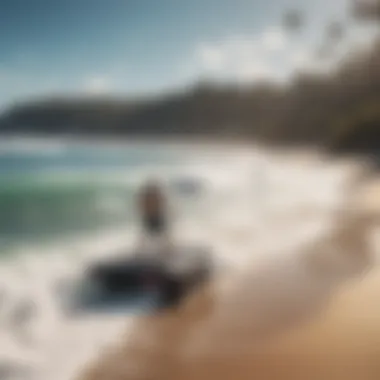

By keeping your ear to the ground, or your eyes on the local guidelines, you can avoid unnecessary run-ins with law enforcement while enjoying your time on the water.
Licensing and Registration
In most places, riding a motorized water board isn't as simple as just hopping on and gunning the engine. Licensing and registration vary widely, depending on the jurisdiction. Some locations require operators to hold a special license or certification, while others may not have such stringent requirements. Despite these variances, here are a few elements worth noting:
- Certification courses: Many regions offer or require certifications that cover safe riding practices. Completing one not only promotes safety but also provides valuable tips that enhance your experience.
- Registration of watercraft: Just like motor vehicles, motorized water boards may need to be registered. This often involves displaying registration numbers on the board itself. Not doing so could lead to fines or seizure of your equipment.
- Insurance requirements: Some jurisdictions might recommend or require liability insurance, providing coverage in case of accidents. This acts like a safety net, ensuring that you won’t be left high and dry should a mishap occur.
"Being informed about the local regulations not only enhances safety but also enriches the overall experience on the water. Keeping in line with the law allows for freedom and enjoyment without the worry of legal hurdles."
By embracing these legal forms and guidelines, you will contribute to a more sustainable and enjoyable community on the water.
Environmental Considerations
The exploration of motorized water boards unfurls a fascinating narrative about innovation and human ingenuity. However, it is essential to be mindful of the environmental aspects that come along with such advancements. The burgeoning popularity of motorized boards has prompted discussions about the consequences for aquatic ecosystems and the surrounding environments. Recognizing the balance between enjoyment and preservation is key in ensuring that water sports do not lead to detrimental impacts on marine life and habitats.
Impact on Marine Life
The interaction between motorized water boards and marine life resonates deeply within discussions of water sports ecology. With their sleek designs and increased speed, these boards can disturb the natural behaviors of various aquatic species. Take dolphins, for instance; they often inhabit coastal areas where water sports thrive. The quick movements and noise from motorized boards could disrupt their hunting routines and mating patterns. Furthermore, breeding grounds can become less accessible due to increased activity from motorized water sports.
As marine ecosystems are already under strain from pollution and climate change, it's imperative for enthusiasts to be equipped with knowledge about their surroundings. Areas like coral reefs, which host vibrant marine life, can be especially vulnerable. Direct contact from motorized boards or the echo of their engines can degrade these delicate habitats.
Awareness is crucial: Observing wildlife from a distance, maintaining a lawful distance from sensitive areas, and minimizing engine noise can help protect marine environments.
"Riding the waves should not come at the cost of our oceans' health. Respect the waters and the life within them."
Sustainability Practices
In response to the potential hazards that motorized water boards pose to marine life, sustainability practices are gaining traction among manufacturers and enthusiasts alike. The emphasis is on promoting eco-friendly innovations that safeguard our oceans while allowing riders to enjoy the thrill of riding. Let’s discuss a few notable practices:
- Electric Propulsion: Many companies are venturing into electric-powered boards. Reducing reliance on fossil fuels not only minimizes pollution but also significantly cuts down engine noise, making the experience quieter for both riders and marine life.
- Recyclable Materials: Selecting boards made from sustainable or recyclable materials can reflect an awareness of environmental responsibilities. Using biopolymers and natural resources helps reduce the ecological footprint.
- Education and Awareness Campaigns: Organizations are increasingly taking steps to educate users about the importance of environmental stewardship. Events that blend fun with learning create a stronger community connection to nature. Riders are reminded to stay informed about the local regulations surrounding water activities and marine conservation.
In looking toward the future, the motorized water board industry is at a crossroads. Consumers and businesses can either march forward with little regard for the environment or embrace practices that honor and protect our marine ecosystems. By fostering a culture of sustainability within water sports, we’re investing in the longevity of both our experiences and the natural wonders that enhance them.
User Experiences
The realm of motorized water boards transcends mere technical prowess; at its heart lies the user experience, a vital aspect that shapes how both casual riders and dedicated enthusiasts interact with the water. It’s not just about gliding atop the waves with a powerful electric motor beneath you, but understanding how those moments feel, the nuances that come with each ride, and the community that gathers around this exhilarating sport. User experiences provide hands-on insights into the joys and challenges of operating motorized boards, forming a bridge between manufacturers' promises and actual performance on the water.
Personal Testimonials
Narratives shared by riders paint a picture that statistics simply cannot convey. From a twenty-something thrill-seeker zipping across Lake Tahoe to retirees exploring the calm waters of the Gulf Coast, testimonies carry weight. For instance, one user, Sarah, spoke about her first time on a motorized board:
"I was so nervous, but once I was out there, it felt like flying! The wind in my hair and the rush of speed—nothing else matters in that moment."
Her excitement showcases how these boards can elevate the experience of being on the water, transforming anxiety into exhilaration. Similarly, James, an instructor, shared how the ease of balancing on an electric board has enabled first-timers to experience the sport without steep learning curves, making water sports more accessible than ever before.
These heartfelt accounts emphasize the emotional connection riders forge with their boards. They reveal that motorized boards often inspire confidence and deepen one’s love for the water, allowing individuals to enjoy the sport who might have felt intimidated otherwise.
Comparative Insights
When placing motorized water boards alongside traditional surfboards, the experiences differ significantly. While traditional surfers may revel in the challenge of catching waves using technique and skill alone, motorized boards introduce an exhilarating ease. Enthusiasts can navigate choppy waters or even explore areas previously inaccessible to surfers, like secluded beaches or remote coves.
While some purists argue that motorized boards strip away the essence of surfing, many acknowledge their potential to fuse technology with nature. For instance, on social media platforms like Reddit, users often debate the pros and cons of both methods of riding, contributing to the vibrant dialogue within the community. The integration of electric propulsion allows riders to experience the thrill of speed while still engaging with the beauty and serenity of the ocean.
Ultimately, personal experiences and comparative insights reveal that motorized water boards have sparked a new wave of interest in water sports, inviting diverse audiences to the scene and fostering a community that embraces innovation and discovery.
Whether you seek adventure, fitness, or relaxation, the user experiences surrounding these boards are rich and varied. They highlight how technology, when harmoniously blended with natural landscapes, can create not just thrilling rides, but also lifelong memories.
Maintenance and Care
Taking care of your motorized water board is as important as mastering the waves themselves. Proper maintenance not only extends the life of your board but also enhances performance and safety. Surfing enthusiasts invest significant time and resources into these innovations, so it’s clear that understanding the intricacies of upkeep is essential. This section will delve into the routine maintenance checklist and common repairs to keep your board riding smoothly.
Routine Maintenance Checklist
Maintaining a motorized water board involves several key steps. Regularly following a maintenance checklist can prevent costly repairs and accidents down the line. Here's a solid list to guide you:
- Inspect the Battery: Check for any signs of wear or corrosion. A healthy battery is crucial for optimal performance.
- Clean the Hull: Remove any salt residues or debris after every use. This prevents damage and keeps the board looking good. Use mild soap and water.
- Check Propulsion System: Regularly inspect the propellers and fins. Damage to these parts can affect speed and navigation.
- Examine Electrical Connections: Make sure all wires are secure. Loose connections can lead to mechanical failures.
- Lubricate Moving Parts: Use suitable marine grease to ensure that all moving parts—like hinges and joints—are functioning smoothly.
- Monitor for Cracks or Dents: Keep an eye out for damage on the board’s surface; even small cracks can lead to larger problems later on.
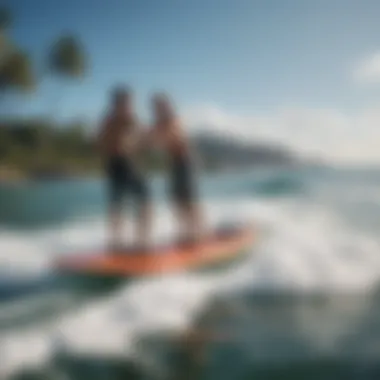
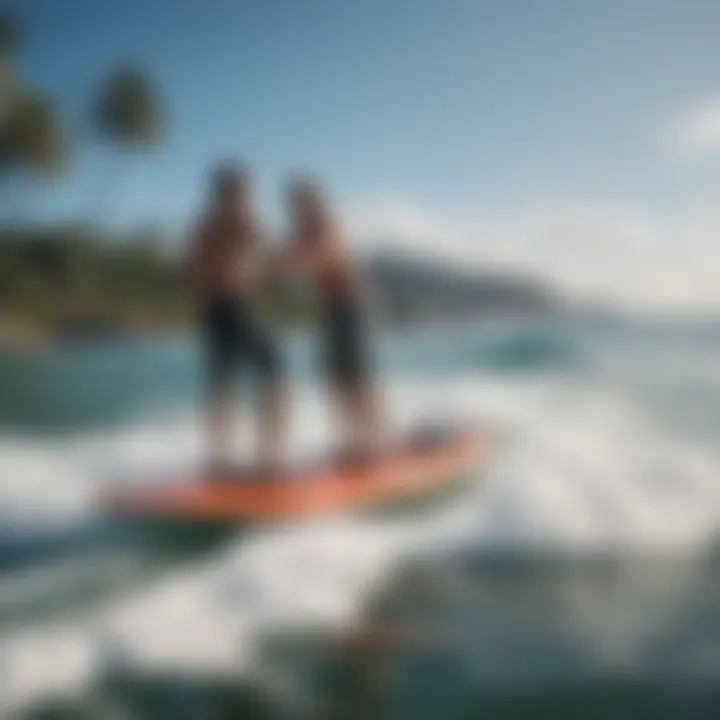
"An ounce of prevention is worth a pound of cure"—this old saying rings especially true when it comes to maintaining motorized water boards.
Common Repairs and Issues
Even with regular maintenance, issues can arise. Here are some common repairs that may come up and how to tackle them effectively:
- Battery Replacement: If the board doesn’t hold charge well, it might be time for a new battery. Ensure compatibility with the existing system when purchasing.
- Propeller Damage: A bent or broken propeller can reduce speed and efficiency. Replacement is essential; check local shops for specific models.
- Water Intrusion: Leaks may occur, especially if seals wear down. To fix this, inspect all seals and replace them if necessary. A quick patch can extend the life of the board significantly.
- Electrical Failures: Issues like the board not turning on can stem from fuse problems or wiring issues. Testing connections and replacing fuses are often straightforward fixes.
- Repairing Cracks: Small cracks can be mended using marine epoxy, certainly much better than letting them worsen.
Caring for your motorized water board isn’t just about keeping it looking good; it’s vital for both safety and performance out on the water. By regular inspection and addressing repairs promptly, users can ensure their boards are ready for every adventure.
Market Trends and Innovations
In recent years, motorized water boards have created ripples in the fabric of water sports. The rapid evolution of technology, paired with changing consumer preferences, has led to a surge in innovations and trends that are reshaping how enthusiasts engage with these boards. The focus on market trends and innovations is paramount in understanding the trajectory of motorized water sports. These elements not only reflect current practices but also give insights into future possibilities, benefiting enthusiasts, manufacturers, and the environment alike.
Emerging Technologies
The backbone of the motorized water board revolution lies in technology. Recent advancements have led to the development of highly efficient electric propulsion systems, which offer a quieter and more environmentally friendly alternative to traditional gas-powered motors. Riders can now enjoy their experience without the disruptive noise often associated with older water sports technologies.
Some notable innovations include:
- Integrated Smart Technologies: Many modern boards come equipped with smartphone connectivity, allowing users to track performance metrics such as speed, distance, and battery life through a dedicated app. This technological integration provides a seamless experience and encourages riders to push their boundaries while keeping safety in mind.
- Lightweight Materials: The use of advanced composites, such as carbon fiber and lightweight plastics, has contributed to the overall performance of the boards. These materials not only reduce the weight of the boards but also enhance their durability, making them more suitable for varied conditions.
- Modular Designs: As the demand for customization grows, some manufacturers are introducing modular designs, where components like fins and battery packs can be swapped out or upgraded, giving users more control and personalization in their ride.
As technology progresses, it reflects an understanding of user needs, ensuring that every detail—from design to performance—is tailored to enhance the surfing experience.
Industry Predictions
Looking ahead, the motorized water board industry is poised for growth. With forecasts indicating an increase in participation in motorized water sports, several trends are beginning to take shape. Insights from industry analysts suggest that:
- Increased Adoption of Eco-Friendly Practices: As environmental awareness grows, manufacturers are likely to focus on sustainability measures, creating boards that use renewable energy sources or biodegradable materials. This shift will appeal to environmentally-conscious consumers who want to enjoy watersports while minimizing their ecological footprint.
- Growth in Rental Markets: With rising interest from novice users, the rental market for motorized water boards is expected to expand. More beach resorts and rental shops will likely include these boards in their offerings, serving as a way for newcomers to experience the sport before making a significant financial commitment.
- Enhanced Training Programs: As the sport diversifies, more training programs and workshops for both novices and advanced users will likely emerge. This focus on education not only raises safety standards but also fosters a community of skilled riders who can contribute to the sport’s culture and progression.
"Anticipating the needs of water sports enthusiasts is crucial to the continued innovation seen in motorized water boards. As we look towards the future, collaboration across industries—marine biology, sports engineering, and eco-conscious manufacturing—will be key."
Community and Culture
The community surrounding motorized water boards is diverse and vibrant, reflecting a mash-up of various cultures that interweave to enhance the sport’s richness. As this innovation takes to the waves, it not only transforms individual experiences but also cultivates a unique social ecosystem among enthusiasts. Understanding community dynamics is crucial for anyone diving into this world, whether you're just starting or you are a seasoned rider.
Social Aspects of Motorized Water Sports
Motorized water sports have ushered in fresh social dynamics that resonate deeply with participants.The shared excitement of gliding over waves tends to create immediate bonds among riders, serving as the heartbeat of this emerging culture. Meetups and community events, like races or friendly competitions, allow individuals to connect over common interests. These gatherings foster a sense of belonging, making participants feel part of something larger than just their individual experiences.
Another significant aspect is how social media platforms, like Facebook and Reddit, have allowed fans and users to create online communities. Group chats and forums buzz with discussions about techniques, gear tips, and personal stories. Sharing photos and videos of their water adventures not only showcases skills but inspires others to either take the plunge or improve their game. It's like a big family sharing and growing together, even if they have yet to meet in person.
Connecting with Other Enthusiasts
Building connections within this community can significantly enhance the overall experience. Whether at local surf shops or beachside cafes, striking up a conversation with fellow enthusiasts often leads to enlightening insights. Sharing tricks or tips on maneuvering those intricate waves transforms the learning experience into a communal venture.
Networking opportunities also abound. Riders can find mentors among old-timers in the sport, who often share invaluable wisdom.
Moreover, specific clubs and associations are popping up, much like the waves they ride. Joining these groups can prove beneficial for both knowledge and camaraderie. Enthusiasts often combine their interests with charity work, organizing events that not only promote the sport but also support local marine conservation efforts, illustrating how this community isn't just about the thrill but also about stewardship of the waters they ride on.
"Shared passions breed stronger connections and elevate communities, leading to a more enriching engagement in any sport."
Delving into the community aspects of motorized water boards reveals more than just a pursuit of personal stunts or achievements. It is about connecting with others, sharing adventures, and contributing to a culture that values not only the thrill of the ride but also the bonds formed along the way.
The Future of Motorized Water Boards
The road ahead for motorized water boards appears to be gleaming with potential. In our ever-evolving technological landscape, these devices are not just a passing fad, but rather a transformative element in the realm of water sports. As enthusiasts, manufacturers, and environmentalists collaborate, several critical elements come to the forefront. The enhancements in performance, safety, accessibility, and sustainability are set to redefine not only how we surf but how surfing is perceived culturally and environmentally.
Potential Developments
The future is likely to usher in a wave of innovations that will elevate the motorized water board experience. Some noteworthy potential developments include:
- Advanced Battery Technologies: The demand for longer battery life and quicker charging times is steadily increasing. Emerging technologies like solid-state batteries may soon replace lithium-ion counterparts, boosting performance while reducing environmental impact.
- Smart Features Integration: Expect to see more motorized boards equipped with smart technology. Features like GPS tracking, performance analytics, and automated safety alerts could change how riders interact with their boards, providing a more enriching surfing experience.
- Enhanced Design Materials: Future boards may utilize lighter, more durable materials such as carbon fiber or innovative composites. This would not only improve speed and agility but also durability, making boards resilient against wear and tear.
- Customizable Options: Riders may find themselves with more personalized choices when selecting their boards. Customizable features that allow surfers to change performance settings based on personal preferences will create a more tailored surfing experience.
"As technology advances, it'll be fascinating to see how it melds with tradition. Riders have always sought a deeper connection with the waves, and innovations will only enhance that bond."
Integrating Technology with Experience
The integration of technology with the physical experience of surfing is crucial as we navigate the future. This balance can be strikingly rewarding, leading to several possibilities:
- Real-time Data Feedback: Riders could receive instant feedback on their performance. Imagine a surfboard that analyzes wave patterns in real-time, adjusting its propulsion in response to conditions. This could particularly benefit instructors and trainers, providing quantitative assessments for students.
- Virtual Reality Training: Combining motorized water boards with virtual reality could revolutionize how surfers train. VR simulations can offer training environments that mimic real-world surfing conditions, allowing newcomers to prep without braving the ocean’s unpredictability.
- Connected Communities: As social media continues to expand, motorized water boards could connect riders around the globe. Platforms that facilitate sharing experiences, organizing meet-ups, or tracking friends' activities could foster a thriving community that shares techniques, tips, and showcases adventures.
- Eco-friendly Advancements: Integrating eco-conscious technology is vital. Future developments may see boards equipped with systems that monitor environmental conditions, enabling surfers to actively contribute to marine conservation efforts.
As motorized water boards continue to carve a path in the surfing culture, their future is filled with promise. The balance between technological advancement and the authentic sense of riding the waves will no doubt shape the next chapter in this exciting evolution.















